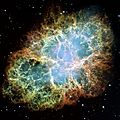Stellar evolution facts for kids
Stellar evolution is how a star changes during its long life. Stars are born, live for millions or billions of years, and then die. They change a lot from when they first appear to when they run out of fuel.
Because stars live for such a long time, scientists study stellar evolution by looking at many different stars. Each star they observe is at a different stage of its life. This helps them understand the entire journey of a star.
The main stages in a star's life are:
- A cloud of gas and dust called a nebula.
- A main-sequence star, like our Sun.
- A red giant.
- Then, depending on its size, it becomes either a white dwarf (which later cools into a black dwarf), a neutron star, or a black hole.

Contents
How a Star Is Born
Every star begins as a huge cloud of gas and dust. This cloud is called a nebula. Over time, the force of gravity pulls this gas and dust closer together. As it gets denser, it starts to heat up. The cloud also begins to spin and takes on a ball-like shape.
When the center of this ball gets hot enough, amazing things happen. It starts to create energy by changing hydrogen into helium. This process is called nuclear fusion. It makes the star shine very brightly. At this point, it becomes what astronomers call a main-sequence star. A star can stay a main-sequence star for billions of years, looking much the same. Our own Sun is a main-sequence star right now!
How a Star Gets Old
Eventually, a star like our Sun uses up almost all the hydrogen in its center. When this happens, the nuclear fusion reaction in its core slows down or stops. The star's gravity then causes its center to shrink.
However, a layer just outside the core starts to fuse hydrogen into helium. This new energy source makes the star's outer layers expand greatly. The star becomes much, much bigger. It can shine up to ten thousand times brighter than before! But because its surface is so huge, the energy spreads out. This makes the surface temperature drop, and its color changes to red or orange. At this stage, it is called a red giant. A red giant can become so big that it might even swallow up any planets orbiting close to it.
How a Star Dies
The way a star dies depends on how big it was to begin with.
Death of a Small Star
After a star like our Sun becomes a red giant, it eventually stops burning. It gently releases its outer layers of gas into space. What is left behind is a small, hot, and very dense star called a white dwarf. Over an incredibly long time, a white dwarf cools down completely. When it no longer gives off heat or light, it becomes a black dwarf.
Death of a Big Star
When a much bigger red giant runs out of fuel, it doesn't just fade away. It explodes in a huge blast called a supernova. This explosion is incredibly powerful and bright.
Instead of a white dwarf, a supernova leaves behind a tiny, super-dense object called a neutron star. A neutron star is so dense that a single teaspoon of its material could weigh as much as the entire Earth! This happens because gravity is so strong it crushes the atoms, making the electrons combine with the protons to form neutrons.
Death of a Very Big Star
The biggest red giants die in the most dramatic way. Their supernova explosion leaves behind something even stranger: a black hole. A black hole forms because gravity is so incredibly strong that it crushes everything, even the protons and neutrons, into an unbelievably small space. The gravity is so powerful that nothing, not even light, can escape from it. Some physicists believe that a black hole collapses all the way down to a tiny, mathematical point called a singularity.
Images for kids
-
Artist's picture of the life cycle of a Sun-like star. It starts as a main-sequence star, then grows into a subgiant and giant, and finally sheds its outer layers to form a planetary nebula.
-
A picture of Antares, a huge red supergiant star.
-
The Crab Nebula is what's left after a star exploded as a supernova in the year 1054 AD.
See also
 In Spanish: Evolución estelar para niños
In Spanish: Evolución estelar para niños








